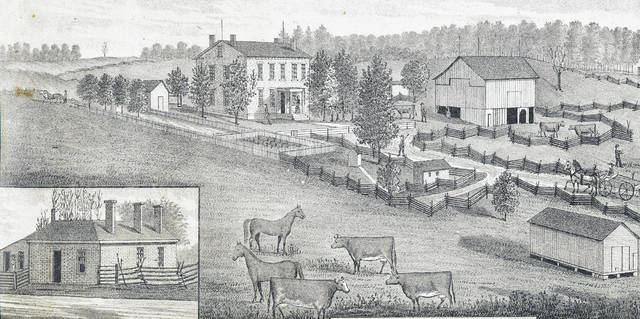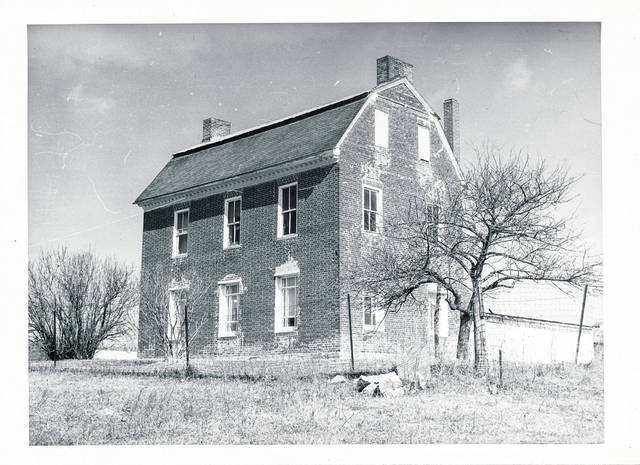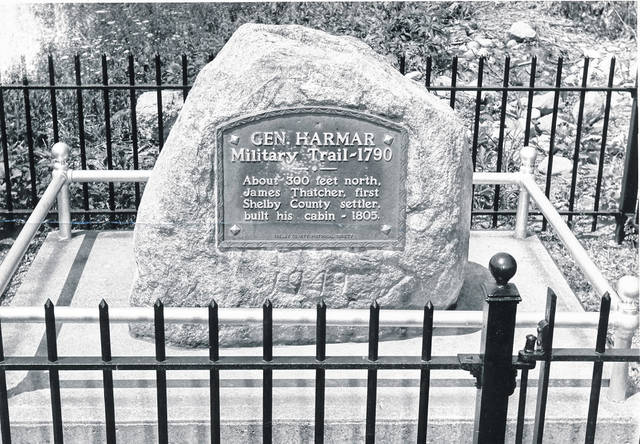



Editor’s note: in conjunction with the 200th celebration of the establishment of Shelby County, the Sidney Daily News will be publishing a year long series about the county’s history.
SIDNEY — Imagine a realm of dense, unbroken forest for as far as you can imagine, with no form of modern civilization anywhere nearby, and you have a vision of what Shelby County was like to its first white settlers. There were no easily accessible roads, the only means of communication were letters on horseback, and the only schools and churches were lessons taught in your own homes. Life was not easy for those brave enough to venture into the Miami Valley region at the turn of the nineteenth century; however hardships along the way did not stop the early pioneers from blazing their own trails.
As quoted in the thoughts of an old pioneer:
“Give me back the days of old; let me go back to my log cabin home beside the Miami, where I took my youthful bride; where with empty hands, but with brave and honest hearts, we fought out the battle of life; where we knew naught of envy, strife, or pride.”
James Thatcher was the first pioneer to arrive in Shelby County in 1805. He and his wife, Hester Cox, made their way with their infant son from the Great Miami River to the Loramie Creek area where they took up residence in the northwest part of what is now Washington Township. There is much still unknown about this family, however it is believed they came north from Kentucky. Thatcher remained until the county’s inception and helped survey the first roads. His son, James Thatcher Jr. moved to Van Wert County by about the 1850’s.
The Mellinger brothers were the next to arrive in 1806. David, John, and Joseph all settled near what became Lockport and later Lockington. This family was extremely interconnected, naming their children after other family members still living, which is a genealogist’s nightmare. From what can be gathered, the family moved to Ohio from Kentucky. Joseph was elected as one of the first County Commissioners in 1819, while David owned the piece of land surveyed by Jonathon Counts in 1837 that became the canal hub of Lockington.
James Cannon and his family arrived shortly after the Mellingers in 1806, settling first in part of Orange Township before moving to the mouth of Loramie Creek. Cannon was born in Ireland on Nov. 12, 1756, and came to the United States at the age of 15. He worked as a tanner’s apprentice for two years before joining the Continental Army where he served under the command of Gen. Washington during the Revolutionary War. By 1808, Cannon moved his family onto the area of land that would eventually become Sidney, his family most likely being the first to make improvements on it. Cannon and his family moved a final time in 1815, where they built a home in Turtle Creek Township just outside of Hardin. He and his wife had a total of seven children. One of them, Abraham, stayed in Clinton Township to help on Charles Starrett’s farm, living in a log cabin that later served as a meeting place until the first court house was built.
Settling a year later along the banks of Turtle Creek in 1807, came John Wilson and his family. Wilson was born in 1774 in Grayson County, Virginia, and in 1799 he married Anna Webb, a native of Georgia and descendent of English royalty who had been a mail courier in her youth during the Revolutionary War. Wilson’s family arrived in Warren County, Ohio, in 1801. In March of 1807, they arrived in Shelby County with their three children and began preparations for a farm. As aggressions between Native Americans and early pioneers progressed, Wilson felt the need to register with the Ohio Militia and served as a private under Capt. Thomas Seton from February to August 1813. In 1816, he built the first brick house in Shelby County, which still stands today as a testament of its time, rival only to the Johnston Farm. Wilson remained active in local politics and was one of the men who helped with our County’s inception, serving as one of the first County Commissioners. In 1841, Wilson met his end from the blow of a falling tree limb and is buried in Carey Cemetery in Hardin.
By 1808, Samuel Marshall and his family arrived in Shelby County as well. Marshall was born in Ireland in 1775, coming to Pennsylvania with his father in 1784. He married Margaret Cracraft and the two moved to Butler County, Ohio, before arriving in Washington Township Marshall is credited with building the first sawmill in the county off of Turtle Creek just north of John Wilson’s establishment. He played a role in establishing a mail route from Piqua to Fort Defiance and Bellefontaine as well as served in the position of County Commissioner and associate judge, the latter of which he held for many years until his death in 1838.
Edward Jackson made the trek from Virginia with his wife and children in 1809, settling in Orange Township (which was then part of Perry Township). He was born on Oct. 14, 1774 in Alleghany County, Virginia, and married his wife, Jane Morris, in Virginia on November 25, 1806. They traveled to Springfield, Ohio, with their two children before finally settling permanently in Shelby County. During the turmoil of the War of 1812 where relations with Native Americans became hostile, Jackson sent his family to Springfield while he remained to clear the land. However, Jane was insistent on staying with her husband and after only a brief time away she returned, by which point he had constructed a blockhouse near the Great Miami River. Jackson was drafted into the militia in 1814, but was able to return after only a few months service. In 1815, Methodist church services were held at the Jackson homestead. He built the first brick house in Orange Twp. just south of Sidney and was one of the men who made a monetary donation to secure Sidney as the county seat. Jackson was the proud father of 11 children and upon his death on Feb. 7, 1851 was buried in the Old Presbyterian Cemetery before being reinterred in Graceland in 1915.
Also arriving in Orange Township in 1809 were the following men: John Phillips, William Berry, and Daniel Valentine. Not much information is known on Phillips except that he came in the springtime. William Berry arrived from Virginia also in the spring, settling near what is now Kirkwood. He received a land grant from the government on September 1, 1811 and built the first frame house and flour mill, which was used by Harrison’s army on its march northwest. A blockhouse was also built near the mill for added protection. Berry was on the first board of County Commissioners, but did not remain in the county permanently. Not much is known about what his life was like after he left, but it is possible he traveled north to Fulton County as a William Berry helped establish a grist mill there in 1835.
Daniel Valentine, who arrived in Orange Township in the fall of 1809, was of Dutch descent. He was born on December 20, 1776 in Union County, New Jersey, and later married Rachel Winans on Feb. 14, 1799. He and his wife traveled first to the Mad River Valley area in Champaign County in 1805 where they remained for four years. Valentine and his family then arrived in Shelby County near Kirkwood, being the fourth family to settle in that township. He established not only a prosperous farm, but also a successful shoemaking business. His son, Richard, learned the trade of blacksmithing and set up a shop near his family’s homestead. After his wife, Rachel, passed away in 1820 he remarried Isabel Jameson. Unfortunately, while visiting his son in Lockington on Feb. 21, 1841, Valentine passed away. He is buried at Wesley Chapel Cemetery, famous for being the burial place of Lewis Boyer, a well-known Revolutionary War soldier.
The following year, Samuel McClure arrived in Shelby County, settling near Loramie and Washington Townships. McClure was born on Nov. 11, 1777, in South Carolina and his story is quite an interesting one. After his marriage to Mary Stewart in 1804, the McClure family started their journey to Ohio, first settling near Dayton along the Little Miami River. By 1810, they had made their way into Shelby County where they remained until the outbreak of the War of 1812. At this point, McClure made his way back to South Carolina until the fall of 1813. On his return trip to Ohio, however, he and the men he was traveling with were seized by the US Service and taken to Fort St. Mary’s where they helped reconstruct the fort and blockhouse. By 1815, he had made his way back to Shelby County and settled along Nine-Mile Creek near present day Houston. McClure and his family remained until Christmas Day of 1826. Minus their son Robert who stayed behind, they made their journey westward to Wabash and Grant Counties in Indiana where he constructed the first mill on the Mississinewa River. After several years of managing the mill he moved back to Wabash where he passed away on September 22, 1838. Samuel McClure was originally rumored to be buried in Wright Cemetery in an unmarked grave, however, after a thorough search, he was found to be interred in McClure Cemetery in Richvalley, Wabash County, Indiana.
Charles Weeks was the final settler to arrive in Shelby County in 1810, within the first five years of settlement. He was born in 1759 along the southern branch of the Potomac River in Virginia. At the young age of 16, he enrolled in his father’s company of the Continental Army and served during the Revolutionary War. In his obituary it is noted that he was present at many of the engagements recorded in history and was partly under the immediate command of Gen. Washington. By 1800, he and his family had moved to Athens County, Ohio, where they were among the first white settlers. In 1810, he was residing in Salem Township of Shelby County. Weeks participated in the War of 1812 despite his age, and while at the surrender of Hull in Detroit was made a prisoner of war. He returned to Shelby County after the war and it was recorded that he received a land grant from the government on March 1, 1815. Weeks settled permanently in Section 20 in the southwest corner of Salem Twp. and was the first to build a house and make land improvements in this area along with being one of the first grand jurors after the establishment of the county. However, by 1822 he had moved himself to Indiana where he settled along the Maumee River near Fort Wayne. Seeing how it was “too crowded” by his standards, Weeks moved yet again near a branch of Cedar Creek. He passed away in Indiana in 1842, leaving behind many saddened by his passing and an impressive obituary in the Fort Wayne Sentinel.
After 1810 and before the War of 1812 there were several more settlers who trickled in to Shelby County, some of whom have very familiar names such as Cephas Carey and the Lenox family, both of whom settled near Hardin. The story of each pioneer is one worth hearing; please stay tuned for the next segment which will go more in depth on the everyday life of a pioneer!
Bibliography
“History of Shelby County, Ohio with Illustrations and Biographical Sketches of Some of Its Prominent Men and Pioneers” published by R. Sutton & Co. in 1883
“History of Shelby County, Ohio, and Representative Citizens” written by A. B. C. Hitchcock in 1913
1846 Tax Assessment of Shelby County
Various birth, marriage, and death records available through Ancestry.com
Various military records available through Fold3.com
“Centennial History of Grant County, Indiana, 1812 to 1912” by R. L. Whitson, J. P. Campbell, and E. L. Goldthwaite
“The County of Fulton” edited by Thomas Mikesell in 1905
“Snow’s History of Adams County, Indiana” written by J. F. Snow in 1907
The obituaries of Judge Samuel Marshall and Charles Weeks





